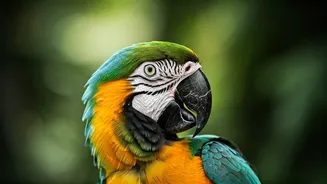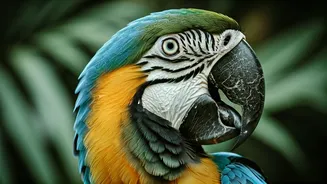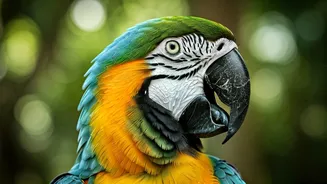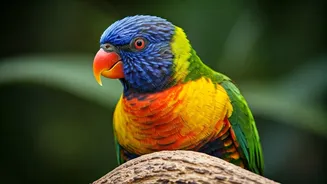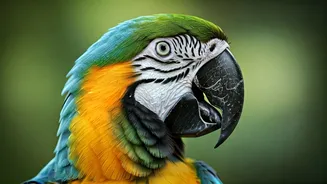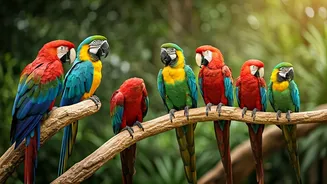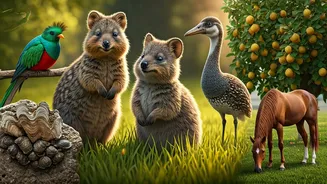Parrot's Clever Minds
Parrots are not just beautiful; they're also remarkably intelligent. Their cognitive abilities are comparable to those of young children and some primates.
Research has shown that they can solve complex problems, understand cause and effect, and even use tools. This high level of intelligence is due in part to their relatively large brains in proportion to their body size, as well as the unique structure of their brains. They can mimic human speech, but they also understand the meaning behind the words. They can learn to associate words with objects, colors, and actions. This intelligence is one reason why parrots make such captivating pets and why they continue to be studied by scientists seeking to understand the nature of intelligence itself. Their ability to learn and adapt showcases a level of intellect often underestimated.
Lifespans of Parrots
One of the most surprising facts about parrots is their longevity. Many parrot species live for decades, and some can even outlive their human companions. Larger species, like macaws and cockatoos, can live for 60 to 80 years or more. This long lifespan necessitates a significant commitment from their owners, as caring for a parrot is a lifelong responsibility. They require consistent care, proper nutrition, and mental stimulation throughout their entire lives. The extended lifespans of parrots are a testament to their resilience and adaptability. In the wild, they face numerous challenges, including predators and habitat loss. However, their longevity makes them a symbol of endurance and a reminder of the importance of conservation efforts to protect their habitats.
The Parrot's Diet
Parrots have a diverse and specific diet that is crucial for their health and well-being. Unlike some animals that can thrive on a simple diet, parrots require a variety of foods to meet their nutritional needs. In the wild, their diet consists of fruits, seeds, nuts, nectar, and sometimes insects. As pets, they need a well-balanced diet that includes high-quality pellets, fresh fruits and vegetables, and some seeds and nuts in moderation. It's essential to avoid foods that are toxic to parrots, such as chocolate, avocado, and caffeine. Proper nutrition is key to preventing health issues and ensuring that they lead long, healthy lives. The importance of a balanced diet reflects the complex digestive systems of these birds, which are adapted to extract nutrients from a wide range of natural food sources.
Social and Complex Lives
Parrots are highly social creatures, and their social interactions are complex. In the wild, they live in flocks, and these groups provide protection, facilitate foraging, and contribute to their social learning. They form strong bonds with each other, often mate for life, and show sophisticated communication through vocalizations, body language, and preening. For pet parrots, social interaction is also vital. They require regular interaction with their owners and other people. Without adequate social stimulation, they can become stressed, bored, or even develop behavioral problems. Providing a stimulating environment that mimics their natural social needs can promote their emotional well-being. This social complexity reveals the intelligence of these birds and their capacity for developing deep emotional bonds.
Parrots: Masters of Flight
Parrots are exceptional flyers, adapted to maneuver in various environments. Their strong wings and lightweight bodies enable them to fly with agility and speed. Flight is essential for finding food, escaping predators, and reaching nesting sites. The shape of their wings and their lightweight, hollow bones are important adaptations for their aerial abilities. Different species have developed unique flight styles depending on their environment. Some are adept at soaring over long distances, while others excel at quick maneuvers through dense forests. Flight is not merely a means of transportation for parrots; it is a critical survival skill and a vital component of their natural behavior. The intricacies of their flight provide insight into the diverse ecological niches that parrots occupy.
Unique Beaks of Parrots
The parrot's beak is a unique and powerful tool. It is curved and hooked, perfectly suited for cracking nuts, seeds, and fruits. The upper and lower parts of the beak work together like a pair of pliers, allowing them to exert immense force. Their beaks also assist with climbing, grooming, and even defense. The strength and structure of the beak vary depending on the species. Parrots use their beaks for a wide variety of tasks, demonstrating their versatility. Their beaks continue to grow throughout their lives, requiring them to chew and grind on hard materials to keep them in proper shape. This adaptation ensures that their beaks remain functional for the essential tasks of feeding and survival.
Parrots and Conservation
Parrots are facing numerous threats in the wild, including habitat destruction, the illegal pet trade, and climate change. Many species are endangered or threatened, and their populations are declining rapidly. Conservation efforts are crucial to protect these incredible birds. This includes protecting their habitats, combatting the illegal pet trade, and educating people about their importance. Supporting parrot conservation helps preserve biodiversity and ensures that future generations can enjoy the beauty and intelligence of parrots. Many organizations around the world focus on parrot conservation, working to restore habitats, rescue and rehabilitate injured birds, and educate the public on the importance of these vital species.
Parrot's Mimicry Abilities
Parrots are renowned for their ability to mimic sounds, particularly human speech. This skill is attributed to their unique vocal anatomy and the structure of their brains. They don't just repeat words; they can also understand the meaning behind what they're saying. They can learn to associate words with objects and even understand complex commands. This remarkable ability to mimic speech is not limited to humans; they can replicate a wide range of sounds. While the exact reasons for mimicry are debated, it is clear that parrots' vocal skills are essential to their survival. The ability to mimic may help them communicate with other parrots, avoid predators, and navigate their environment. Their ability to mimic is evidence of their intelligence and adaptability.
